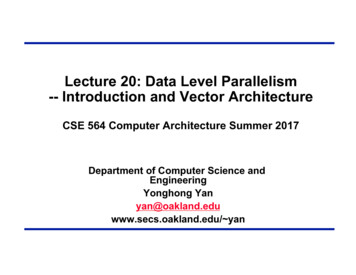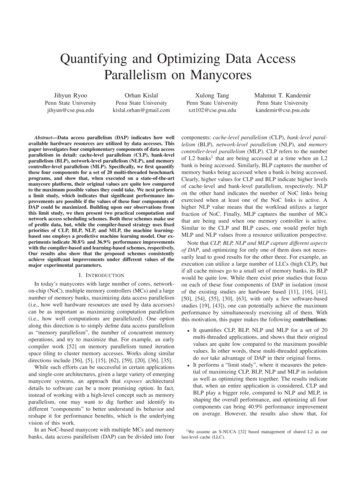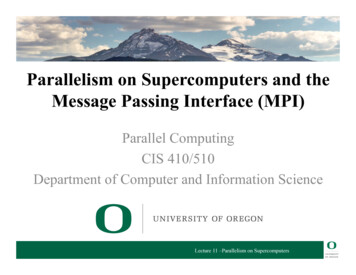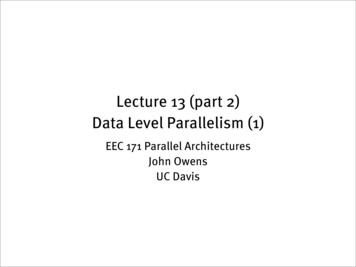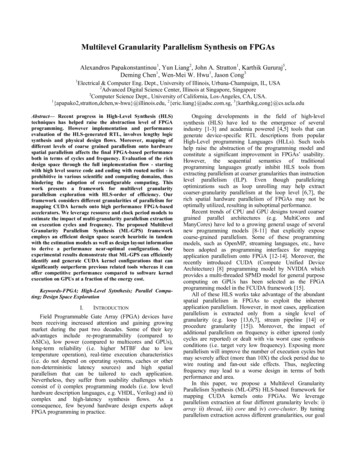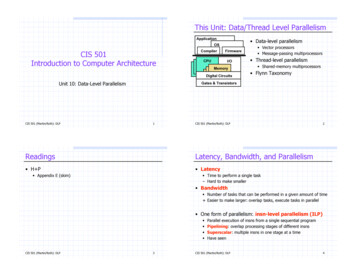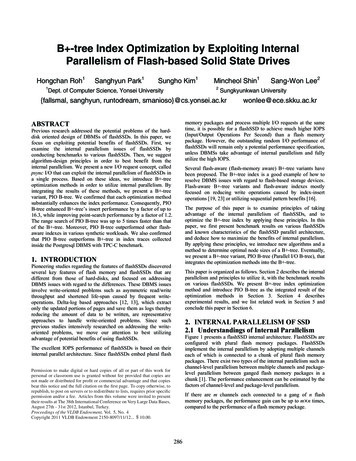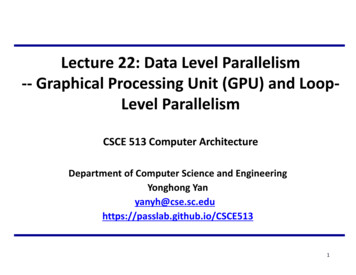
Transcription
Lecture 22: Data Level Parallelism-- Graphical Processing Unit (GPU) and LoopLevel ParallelismCSCE 513 Computer ArchitectureDepartment of Computer Science and EngineeringYonghong 131
Topics for Data Level Parallelism (DLP) Parallelism (centered around )– Instruction Level Parallelism– Data Level Parallelism– Thread Level Parallelism DLP Introduction and Vector Architecture– 4.1, 4.2 SIMD Instruction Set Extensions for Multimedia– 4.3 Graphical Processing Units (GPU)– 4.4 GPU and Loop-Level Parallelism and Others– 4.4, 4.5
Computer GraphicsGPU: Graphics Processing Unit3
Graphics Processing Unit (GPU)Image: gl/CG BasicsTheory.html4
Recent GPU Architecture Unified Scalar Shader Architecture Highly Data Parallel Stream ProcessingImage: gl/CG BasicsTheory.htmlAn Introduction to Modern GPU Architecture, Ashu Rege, NVIDIA Director of Developer /seminar/TDCI Arch.pdf5
Unified Shader ArchitectureFIGURE A.2.5 Basic unified GPU architecture. Example GPU with 112 streaming processor (SP) cores organized in 14streaming multiprocessors (SMs); the cores are highly multithreaded. It has the basic Tesla architecture of an NVIDIAGeForce 8800. The processors connect with four 64-bit-wide DRAM partitions via an interconnection network. Each SM haseight SP cores, two special function units (SFUs), instruction and constant caches, a multithreaded instruction unit, and a 6shared memory. Copyright 2009 Elsevier, Inc. All rights reserved.
GPU Today It is a processor optimized for 2D/3D graphics, video, visual computing, and display.It is highly parallel, highly multithreaded multiprocessoroptimized for visual computing.It provide real-time visual interaction with computedobjects via graphics images, and video.It serves as both a programmable graphics processor and ascalable parallel computing platform.– Heterogeneous systems: combine a GPU with a CPU It is called as Many-core7
Latest NVIDIA Volta GV100 GPU Released May 2017– Total 84 Stream Multiprocessors (SM) Cores– 5120 FP32 cores Can do FP16 also– 2560 FP64 cores– 640 Tensor cores Memory––––16G HBM2L2: 6144 KBShared memory: 96KB * 80 (SM)Register File: 20,480 KB nside-volta/8
SM of Volta GPU Released May 2017– Total 84 SM Cores– 5120 FP32 cores Can do FP16 also– 2560 FP64 cores– 640 Tensor cores Memory––––16G HBM2L2: 6144 KBShared memory: 96KB * 80 (SM)Register File: 20,480 KB (Huge)9
SM of Volta GPU Released May 2017– Total 84 SM Cores– 5120 FP32 cores Can do FP16 also– 2560 FP64 cores– 640 Tensor cores Memory––––16G HBM2L2: 6144 KBShared memory: 96KB * 80 (SM)Register File: 20,480 KB (Huge)10
GPU Performance Gains Over guide11
GPU Performance Gains Over CPU12
Programming for NVIDIA guide/13
CUDA(Compute Unified Device Architecture)Both an architecture and programming model Architecture and execution model– Introduced in NVIDIA in 2007– Get highest possible execution performance requiresunderstanding of hardware architecture Programming model– Small set of extensions to C– Enables GPUs to execute programs written in C– Within C programs, call SIMT “kernel” routines that areexecuted on GPU.14
CUDA Thread Parallelism in Vector/SIMD is the combination of lanes (#PUs) and vector length CUDA thread is a unified term that abstract the parallelismfor both programmers and GPU execution model– Programmer: A CUDA thread performs operations for one dataelement (think of this way as of now) There could be thousands or millions of threads– A CUDA thread represents a hardware FU GPU calls it a core (much simpler than a conventional CPUcore) Hardware-level parallelism is more explicit15
CUDA Thread Hierarchy: Allows flexibility andefficiency inprocessing 1D, 2-D,and 3-D data on GPU. Linked to internalCan be 1, 2 or 3dimensionsorganization Threads in one blockexecute together.16
DAXPY// DAXPY in CUDAglobalvoid daxpy(int n, double a, double *x, double *y) {int i blockIdx.x*blockDim.x threadIdx.x;if (i n) y[i] a*x[i] y[i];}Each thread finds it element to compute and do the work.// Invoke DAXPY with 256 threads per Thread Blockint nblocks (n 255) / 256;daxpy nblocks, 256 (n, 2.0, x, y);Creating a number of threads which is (or slightly greater) the number ofelements to be processed, and each thread launch the same daxpy function.17
DAXPY with Device Codeglobal void daxpy( ) CUDA C/C keyword global indicates a functionthat:– Runs on the device– Is called from host code nvcc compiler separates source code into host anddevice components– Device functions (e.g. axpy()) processed by NVIDIA compiler– Host functions (e.g. main()) processed by standard hostcompiler gcc, cl.exe18
DAXPY with Device COdeaxpy num blocks,num threads (); Triple angle brackets mark a callfrom host code to device code– Also called a “kernel launch”– . parameters are for threaddimensionality That’s all that is required toexecute a function on the GPU!19
GPU Computing – Offloading Computation The GPU is connected to the CPU by a reasonable fast bus(8 GB/s is typical today): PCIe Terminology– Host: The CPU and its memory (host memory)– Device: The GPU and its memory (device memory)20
Simple Processing FlowPCI Bus1. Copy input data from CPU memory toGPU memory21
Simple Processing FlowPCI Bus1. Copy input data from CPU memory toGPU memory2. Load GPU program and execute,caching data on chip for performance22
Simple Processing FlowPCI Bus1. Copy input data from CPU memory toGPU memory2. Load GPU program and execute,caching data on chip for performance3. Copy results from GPU memory toCPU memory23
// DAXPY in CUDAglobalvoid daxpy(int n, double a, double *x, double *y) {int i blockIdx.x*blockDim.x threadIdx.x;if (i n) y[i] a*x[i] y[i];}int main(void) {int n 1024;double a;double *x, *y; /* host copy of x and y */double *x d; *y d; /* device copy of x and y */int size n * sizeof(double)// Alloc space for host copies and setup valuesx (double *)malloc(size); fill doubles(x, n);y (double *)malloc(size); fill doubles(y, n);Offloading ComputationCUDA kernelserial code// Alloc space for device copiescudaMalloc((void **)&d x, size);cudaMalloc((void **)&d y, size);// Copy to devicecudaMemcpy(d x, x, size, cudaMemcpyHostToDevice);cudaMemcpy(d y, y, size, cudaMemcpyHostToDevice);// Invoke DAXPY with 256 threads per Blockint nblocks (n 255) / 256;daxpy nblocks, 256 (n, 2.0, x d, y d);// Copy result back to hostcudaMemcpy(y, d y, size, cudaMemcpyDeviceToHost);// Cleanupfree(x); free(y);cudaFree(d x); cudaFree(d y);return 0;parallel exe on GPUserial code}24
CUDA Programming Model for NVIDIA GPUs The CUDA API is split into:– The CUDA Management API– The CUDA Kernel API The CUDA Management API is for a variety of operations– GPU memory allocation, data transfer, execution, resourcecreation– Mostly regular C function and calls The CUDA Kernel API is used to define the computation tobe performed by the GPU– C extensions25
CUDA Kernel, i.e. Thread Functions A CUDA kernel:– Defines the operations to be performed by a single thread onthe GPU– Just as a C/C function defines work to be done on the CPU– Syntactically, a kernel looks like C/C with some extensionsglobal void kernel(.) {.}– Every CUDA thread executes the same kernel logic (SIMT)– Initially, the only difference between threads are their threadcoordinates26
Programming View: How are CUDA threadsorganized? CUDA thread hierarchy– Thread Block SIMT Groups that runconcurrently on an SM Can barrier sync and have shared access to theSM shared memory– Grid All Thread Blocks created by the samekernel launch Shared access to GPU global memory Launching a kernel is simple and similar to a function call.– kernel name and arguments– # of thread blocks/grid and # of threads/block to create:kernel nblocks,threads per block (arg1, arg2, .);27
How are CUDA threads organized? Threads can be configured in one-, two-, or threedimensional layouts– One-dimensional blocks and grids:int nblocks 4;int threads per block 8;kernel nblocks, threads per block (.);Block 0Block 1Block 2Block 328
How are CUDA threads organized? Threads can be configured in one-, two-, or threedimensional layouts– Two-dimensional blocks and grids:dim3 nblocks(2,2)dim3 threads per block(4,2);kernel nblocks, threads per block (.);29
How are CUDA threads organized? Threads can be configured in one-, two-, or threedimensional layouts– Two-dimensional grid and one-dimensional blocks:dim3 nblocks(2,2);int threads per block 8;kernel nblocks, threads per block (.);30
How are CUDA threads organized? The number of blocks and threads per block is exposedthrough intrinsic thread coordinate variables:– Dimensions– IDsVariableMeaninggridDim.x, gridDim.y,gridDim.zNumber of blocks in a kernellaunch.blockIdx.x, blockIdx.y,blockIdx.zUnique ID of the block thatcontains the current thread.blockDim.x, blockDim.y,blockDim.zNumber of threads in each block.threadIdx.x, threadIdx.y,threadIdx.zUnique ID of the current threadwithin its block.31
How are CUDA threads organized?to calculate a globally unique ID for a thread inside a onedimensional grid and one-dimensional block:kernel 4, 8 (.);global void kernel(.) {int tid blockIdx.x * blockDim.x threadIdx.x;.}blockIdx.x 2;blockDim.x 8;threadIdx.x 2;Block 0Block 1Block 2Block 30 1 2 3 4 5 6 7832
How are CUDA threads organized? Thread coordinates offer a way to differentiate threadsand identify thread-specific input data or code paths.– Co-relate data and computation, a mappingglobal void kernel(int *arr) {int tid blockIdx.x * blockDim.x threadIdx.x;if (tid 32) {arr[tid] f(arr[tid]);} else {arr[tid] g(arr[tid]);code path for threads with tid 32code path for threads with tid 32}Thread Divergence: useless code path is executed, but thendisabled in SIMT execution model (EXE-commit, more later33
How is GPU memory managed? CUDA Memory Management API––––Allocation of GPU memoryTransfer of data from the host to GPU memoryFree-ing GPU memoryFoo(int A[][N]) { }Host FunctionCUDA ee34
How is GPU memory managed?cudaError t cudaMalloc(void **devPtr,size t size);– Allocate size bytes of GPU memory and store their addressat *devPtrcudaError t cudaFree(void *devPtr);– Release the device memory allocation stored at devPtr– Must be an allocation that was created using cudaMalloc35
How is GPU memory managed?cudaError t cudaMemcpy(void *dst, const void *src, size t count,enum cudaMemcpyKind kind);– Transfers count bytes from the memory pointed to by src todst– kind can be: cudaMemcpyHostToHost, cudaMemcpyHostToDevice, cudaMemcpyDeviceToHost, cudaMemcpyDeviceToDevice– The locations of dst and src must match kind, e.g. if kind iscudaMemcpyHostToDevice then src must be a host array anddst must be a device array36
How is GPU memory managed?void *d arr, *h arr;h addr ; /* init host memory and data */// Allocate memory on GPU and its address is in d arrcudaMalloc((void **)&d arr, nbytes);// Transfer data from host to devicecudaMemcpy(d arr, h arr, nbytes,cudaMemcpyHostToDevice);// Transfer data from a device to a hostcudaMemcpy(h arr, d arr, nbytes,cudaMemcpyDeviceToHost);// Free the allocated memorycudaFree(d arr);37
CUDA Program Flow At its most basic, the flow of a CUDA program is asfollows:1.2.3.4.5.Allocate GPU memoryPopulate GPU memory with inputs from the hostExecute a GPU kernel on those inputsTransfer outputs from the GPU back to the hostFree GPU memory38
// DAXPY in CUDAglobalvoid daxpy(int n, double a, double *x, double *y) {int i blockIdx.x*blockDim.x threadIdx.x;if (i n) y[i] a*x[i] y[i];}int main(void) {int n 1024;double a;double *x, *y; /* host copy of x and y */double *x d; *y d; /* device copy of x and y */int size n * sizeof(double)// Alloc space for host copies and setup valuesx (double *)malloc(size); fill doubles(x, n);y (double *)malloc(size); fill doubles(y, n);Offloading ComputationCUDA kernelserial code// Alloc space for device copiescudaMalloc((void **)&d x, size);cudaMalloc((void **)&d y, size);// Copy to devicecudaMemcpy(d x, x, size, cudaMemcpyHostToDevice);cudaMemcpy(d y, y, size, cudaMemcpyHostToDevice);// Invoke DAXPY with 256 threads per Blockint nblocks (n 255) / 256;daxpy nblocks, 256 (n, 2.0, x d, y d);// Copy result back to hostcudaMemcpy(y, d y, size, cudaMemcpyDeviceToHost);// Cleanupfree(x); free(y);cudaFree(d x); cudaFree(d y);return 0;parallel exe on GPUserial code}39
GPU Multi-Threading (SIMD) NVIDIA calls it Single-Instruction, Multiple-Thread (SIMT)– Many threads execute the same instructions in lock-step A warp (32 threads) Each thread vector lane; 32 lanes lock step– Implicit synchronization after every instruction (think vectorparallelism)SIMT40
GPU Multi-Threading In SIMT, all threads share instructions but operate on theirown private registers, allowing threads to store threadlocal stateSIMT41
GPU Multi-Threading GPUs execute many groups of SIMT threads in parallel– Each executes instructions independent of the othersSIMT Group (Warp) 0SIMT Group (Warp) 142
Warp SwitchingSMs can support more concurrent SIMT groups than corecount would suggest à Coarse grained multiwarpping(the term I coined)– Similar to coarse-grained multi-threading Each thread persistently stores its own state in aprivate register set– Enable very efficient context switching between warps SIMT warps block if not actively computing– Swapped out for other, no worrying about losing state Keeping blocked SIMT groups scheduled on an SMwould waste cores43
Execution Model to Hardware This leads to a nested thread hierarchy on GPUsSIMTGroupSIMT Groups thatconcurrently run on thesame SMSIMT Groups thatexecute together on thesame GPU44
NVIDIA PTX (Parallel Thread Execution) ISA Compiler target (Not hardware ISA)– Similar to X86 ISA, and use virtual register– Both translate to internal form (micro-ops in x86) X86’s translation happens in hardware at runtime NVIDIA GPU PTX is translated by software at load time Basic format (d is destination, a, b and c are operands)opcode.type d, a, b, c;45
Basic PTX Operations (ALU, MEM, and Control)46
NVIDIA PTX GPU ISA ExampleDAXPYglobalvoid daxpy(int n, double a, double *x, double *y) {int i blockIdx.x*blockDim.x threadIdx.x;if (i n) y[i] a*x[i] y[i];}shl.s32 R8, blockIdx, 9(512 or 29)add.s32 R8, R8, threadIdxld.global.f64 RD0, [X R8]ld.global.f64 RD2, [Y R8]mul.f64 R0D, RD0, RD4(scalar a)add.f64 R0D, RD0, RD2st.global.f64 [Y R8], RD0; Thread Block ID * Block size; R8 i my CUDA thread ID; RD0 X[i]; RD2 Y[i]; Product in RD0 RD0 * RD4; Sum in RD0 RD0 RD2 (Y[i]); Y[i] sum (X[i]*a Y[i])47
Conditional Branching in GPU Like vector, GPU branch hardware uses internal masks Also uses– Branch synchronization stack Entries consist of masks for each core I.e. which threads commit their results (all threads execute)– Instruction markers to manage when a branch diverges into multipleexecution paths Push on divergent branch– and when paths converge Act as barriers Pops stack Per-thread-lane 1-bit predicate register, specified byprogrammer48
Conditional Branching in GPU – Mask and commit Branch divergence– Hurt performance andefficiencya 3b 4if (a b) {max a;Disabledexecution by multi-threadsSIMT threads can be“disabled” when they needto execute instructionsdifferent from others in theirgroupa 4b 3} else {Disabled Instruction lock-stepmax b;}49
PTX Exampleif (X[i] ! 0)X[i] X[i] – Y[i];else X[i] Z[i];ld.global.f64RD0, [X R8]setp.neq.s32@!P1, braP1, RD0, #0ELSE1, *Push; RD0 X[i]; P1 is predicate register 1; Push old mask, set new mask bits; if P1 false, go to ELSE1ld.global.f64RD2, [Y R8]sub.f64RD0, RD0, RD2; RD2 Y[i]; Difference in RD0st.global.f64[X R8], RD0; X[i] RD0@P1, bra; complement mask bitsENDIF1, *Comp; if P1 true, go to ENDIF1ELSE1:ENDIF1:ld.global.f64 RD0, [Z R8] ; RD0 Z[i]st.global.f64 [X R8], RD0; X[i] RD0 next instruction , *Pop; pop to restore old mask50
NVIDIA GPU Memory Structures Each core has private section ofoff-chip DRAM– “Private memory”– Contains stack frame, spillingregisters, and private variables Each SM processor also haslocal memory– Shared by cores/threads within aSM/block Memory shared by SMprocessors is GPU Memory– Host can read and write GPUmemorySMSP SP SP SPSP SP SP SPSP SP SP SPSP SP SP SPSHAREDMEMORYGLOBAL MEMORY(ON DEVICE)51
GPU Memory for CUDA ProgrammingLocal variables, etcExplicitly managedusing sharedcudaMalloc52
Shared Memory Allocation Shared memory can be allocated statically or dynamically Statically Allocated Shared Memory– Size is fixed at compile-time– Can declare many statically allocated shared memoryvariables– Can be declared globally or inside a device function– Can be multi-dimensional arraysshared int s arr[256][256];53
Shared Memory Allocation Dynamically Allocated Shared Memory– Size in bytes is set at kernel launch with a third kernel launchconfigurable– Can only have one dynamically allocated shared memoryarray per kernel– Must be one-dimensional arraysglobal void kernel(.) {extern shared int s arr[];.}kernel nblocks, threads per block,shared memory bytes (.);54
GPU Memory More complicated Different usage scope Different size, and performance– Latency and bandwidth– Read-only or R/W cacheSIMT Thread Groups on a GPUSIMT Thread Groups on an SMSIMT Thread GroupRegistersLocal MemoryOn-Chip Shared MemoryGlobal MemoryConstant MemoryTexture Memory55
GPU and Manycore ArchitectureWe only INTRODUCE the programming interface andarchitectureFor more info:– http://docs.nvidia.com/cuda/– Professional CUDA C Programming, John Cheng MaxGrossman Ty McKercher September 8, 2014, John Wiley &SonsOther Related info– AMD GPU and OpenCL– Programming with Accelerator using pragma OpenMP and OpenACC56
Loop-Level Parallelism Focuses on determining whether data accesses in lateriterations are dependent on data values produced in earlieriterations– Loop-carried dependence Example 1:for (i 999; i 0; i i-1)x[i] x[i] s; No loop-carried dependence57
Loop-Level Parallelism Example 2:for (i 0; i 100; i i 1) {S1: A[i 1] A[i] C[i];S2: B[i 1] B[i] A[i 1];}/* S1 *//* S2 */ S1 and S2 use values computed by S1 and S2 in previousiteration: loop-carried dependency à serial execution– A[i] à A[i 1], B[i] à B[i 1] S2 uses value computed by S1 in same iteration à notloop carried– A[i 1] à A[i 1]58
Loop-Level Parallelism Example 3:for (i 0; i 100; i i 1) {A[i] A[i] B[i];/* S1 */B[i 1] C[i] D[i]; /* S2 */}S1 uses value computed by S2 in previous iteration but dependence is notcircular so loop is parallel Transform to:A[0] A[0] B[0];for (i 0; i 99; i i 1) {B[i 1] C[i] D[i];A[i 1] A[i 1] B[i 1];}B[100] C[99] D[99];59
Loop-Level Parallelism Example 4:for (i 0;i 100;i i 1) {A[i] B[i] C[i];/* S1 */D[i] A[i] * E[i];/* S2 */}No need to store A[i] in S1and then load A[i] in S2 Example 5:for (i 1;i 100;i i 1) {Y[i] Y[i-1] Y[i];}Recurrence: for exploring pipeliningparallelism between iterations60
Finding dependencies Assume indices are affine:– a x i b (i is loop index and a and b are constants) Assume:––––Store to a x i b, thenLoad from c x i di runs from m to nDependence exists if: Given j, k such that m j n, m k n Store to a x j b, load from a x k d, and a x j b c x k d61
Finding dependencies Generally cannot determine at compile time Test for absence of a dependence:– GCD test: If a dependency exists, GCD(c,a) must evenly divide (d-b) Example:for (i 0; i 100; i i 1) {X[2*i 3] X[2*i] * 5.0;}a 2, b 3, c 2, and d 0, then GCD(a,c) 2, and d b 3. Since2 does not divide 3, no dependence is possible.62
Finding dependencies Example 2:for (i 0; i 100; i i 1) {Y[i] X[i] / c; /* S1 */X[i] X[i] c; /* S2 */Z[i] Y[i] c; /* S3 */Y[i] c - Y[i]; /* S4 */} True dependencies:– S1 to S3 and S1 to S4 because of Y[i], not loop carried Antidependence:– S1 to S2 based on X[i] and S3 to S4 for Y[i] Output dependence:– S1 to S4 based on Y[i]63
Reductions Reduction Operation:for (i 9999; i 0; i i-1)sum sum x[i] * y[i]; Transform to for (i 9999; i 0; i i-1)sum [i] x[i] * y[i];for (i 9999; i 0; i i-1)finalsum finalsum sum[i]; Do on p processors: for (i 999; i 0; i i-1)finalsum[p] finalsum[p] sum[i 1000*p];Note: assumes associativity!64
Dependency Analysis Mostly done by compiler before vectorization– Can be conservative if compiler is not 100% sure For programmer:– Write code that can be easily analyzed by compiler forvectorization– Use explicit parallel model such as OpenMP or CUDAhttps://computing.llnl.gov/tutorials/openMP/65
Wrap-Ups (Vector, SIMD and GPU) Data-level parallelism66
Topics for Data Level Parallelism (DLP) Parallelism (centered around -Instruction Level Parallelism -Data Level Parallelism -Thread Level Parallelism DLP Introduction and Vector Architecture -4.1, 4.2 SIMD Instruction Set Extensions for Multimedia -4.3 Graphical Processing Units (GPU) -4.4 GPU and Loop-Level Parallelism and Others
